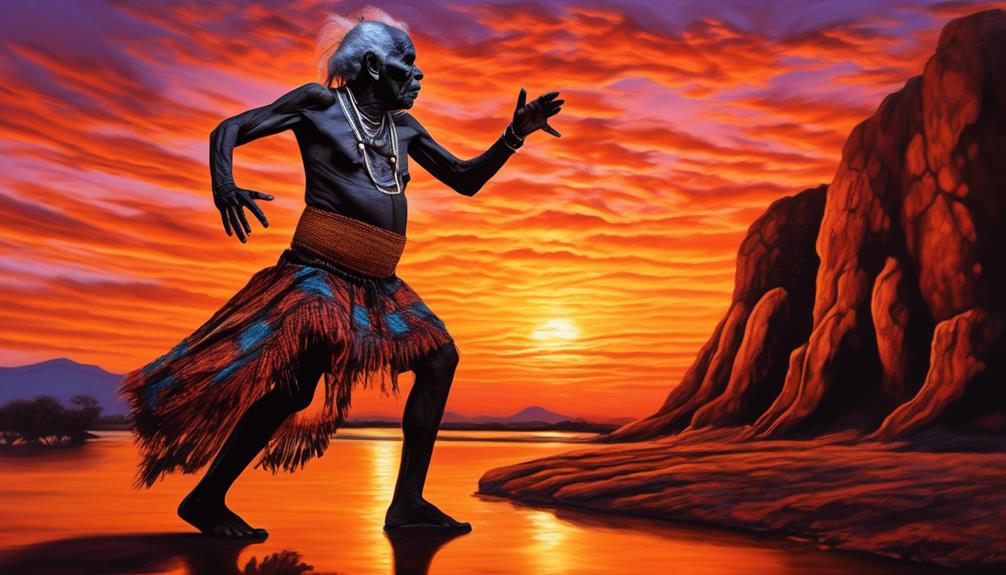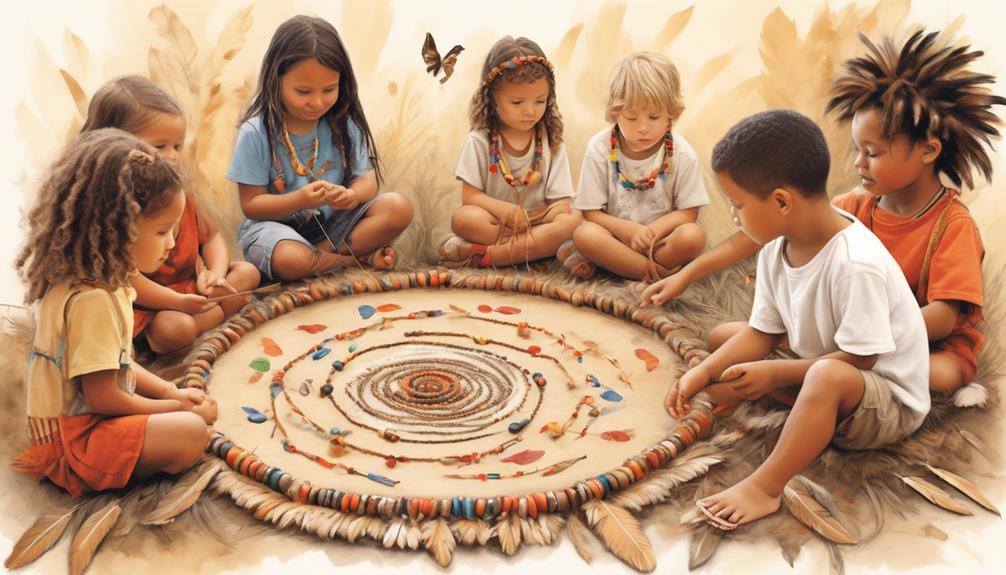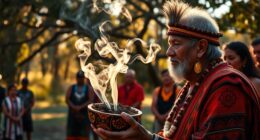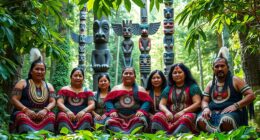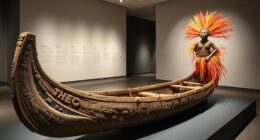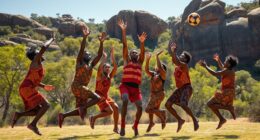We have all heard about the breathtaking landscapes and unique wildlife in Australia, but how much do we actually know about the Aboriginal people who have called this land home for thousands of years?
The history, culture, and ongoing struggles of the Aboriginal and Torres Strait Islander peoples are often overlooked in mainstream discussions about Australia. However, their stories are essential for understanding the complex tapestry of this nation.
From traditional cultural practices to the impact of colonization, there's a lot to uncover about the Indigenous people of Australia.
Key Takeaways
- Indigenous communities in Australia have a rich cultural heritage, including diverse oral traditions, ceremonial rituals, and traditional practices such as hunting and food gathering.
- The arrival of European settlers disrupted traditional ways of life and threatened the preservation of Indigenous knowledge and practices.
- Indigenous communities have a deep spiritual and reciprocal connection to the land, and their environmental stewardship is rooted in cultural traditions.
- Indigenous peoples in Australia have actively fought for land rights and cultural preservation, demonstrating resilience and determination in their pursuit of justice and sovereignty.
Early Indigenous History
The early history of Indigenous people in Australia is marked by a deep connection to the land and a rich cultural heritage that has been passed down through generations. Our ancestors had a profound understanding of the land, its rhythms, and the delicate balance of nature. They lived in harmony with the environment, shaping their way of life around its abundance. This deep connection to the land is a fundamental aspect of our identity and spirituality.
Before the arrival of European settlers, Indigenous communities thrived across the vast Australian continent. Their societies were diverse and complex, with rich oral traditions that conveyed knowledge, history, and spiritual beliefs. These oral traditions were a way of passing down wisdom from one generation to the next, keeping the stories and customs of our people alive.
The early settlement by European colonizers marked a significant turning point in our history. It led to the disruption of our traditional ways of life, the loss of land, and the suppression of our cultural practices. Despite these challenges, our resilience and commitment to preserving our heritage have been unwavering.
It is essential to recognize the impact of early settlement on Indigenous communities and the ongoing legacy of that history. By understanding this past, we can work towards reconciliation and create a future where Indigenous voices are heard, and our cultural heritage is respected and celebrated.
Traditional Cultural Practices
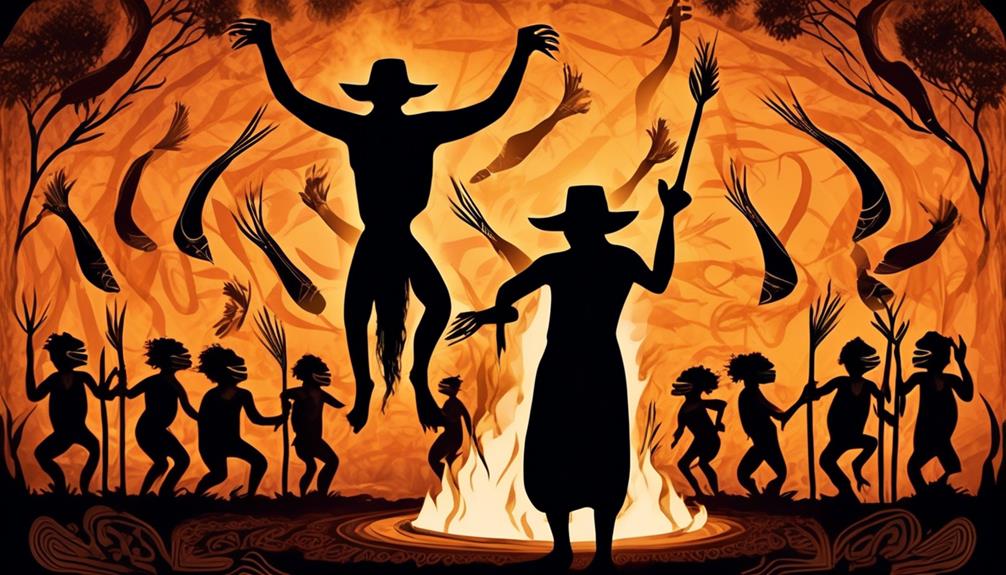
Steeped in tradition and passed down through generations, our cultural practices have been a source of resilience and identity for Indigenous communities in Australia. Ceremonial rituals and storytelling are integral components of our cultural heritage. These rituals, often involving dance, music, and symbolic body paintings, serve as a way to connect with our ancestors, the land, and the spiritual realm. Through storytelling, we preserve our history, traditions, and knowledge, ensuring that our identity remains intact for future generations.
In addition to ceremonial rituals and storytelling, our traditional practices also encompass hunting techniques and food gathering. These methods have sustained our communities for millennia and are deeply tied to the land. The knowledge of which plants are edible, how to track and hunt game, and the seasonal patterns of food availability has been crucial for our survival and wellbeing. Our connection to the land isn't just physical; it's deeply spiritual and rooted in reciprocity and respect for the natural world.
As Indigenous peoples, these cultural practices are more than mere customs; they're a way of life. They embody our values, our spirituality, and our understanding of the interconnectedness of all living things. Despite the challenges posed by colonization and modernization, we continue to honor and perpetuate these traditions, finding strength and resilience in our cultural heritage.
Connection to the Land
Rooted in our deep spiritual connection to the land, our Indigenous communities have cultivated a profound and enduring bond with the natural world. Our land connection isn't merely physical; it encompasses a spiritual and cultural relationship that defines our identity and sustains our existence. We view the land as a living entity, imbued with the essence of our ancestors and the wisdom of countless generations. This profound connection instills in us a deep sense of responsibility as environmental stewards, guiding our actions and decisions to ensure the preservation and flourishing of the land for future generations.
Our understanding of environmental stewardship is deeply rooted in our cultural practices and traditions. For countless years, we've lived in harmony with the land, utilizing sustainable practices that ensure the balance and vitality of our natural surroundings. Our respect for the land is reflected in our conservation efforts, as we recognize that our well-being is intricately tied to the health of the environment. We actively engage in practices that honor the land, such as controlled burning to regenerate growth, traditional hunting and gathering techniques that prioritize sustainability, and the protection of sacred sites that embody the spiritual essence of our connection to the land.
In embracing our role as environmental stewards, we strive to impart the wisdom of our ancestors to future generations, fostering a deep reverence for the land and a commitment to its preservation. Our land connection and environmental stewardship are integral to our cultural heritage, shaping our values and guiding our actions as we continue to protect and nurture the natural world that sustains us.
Impact of Colonization
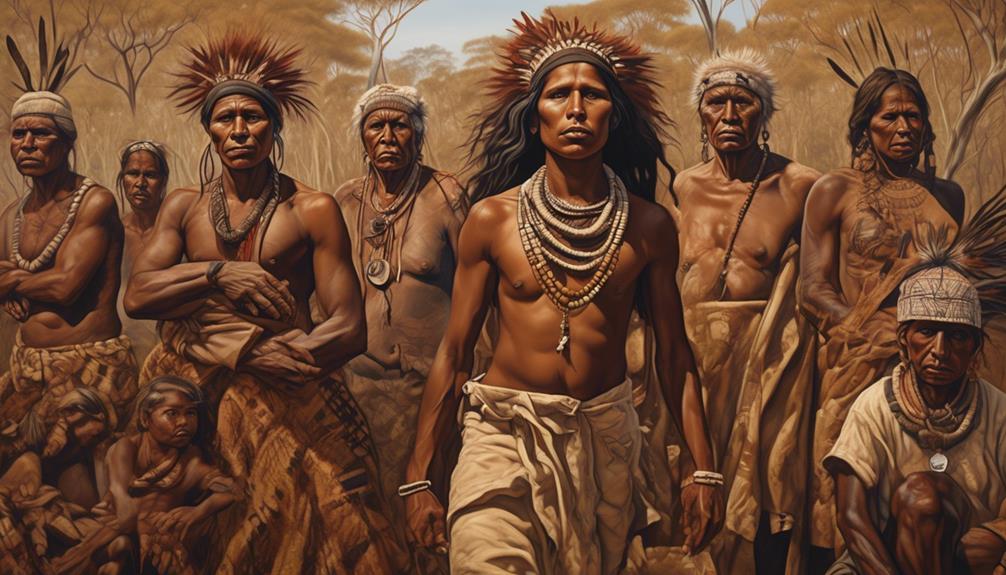
Our Indigenous communities have experienced a profound and enduring impact as a result of colonization, shaping our identity and challenging our cultural traditions. The impact of colonization on our people has been multifaceted and continues to reverberate through generations. Our cultural preservation has been deeply affected, with traditional practices, languages, and spiritual beliefs being threatened. The imposition of foreign systems of governance and education has disrupted our traditional ways of life, leading to a loss of cultural knowledge and practices.
Despite these challenges, our communities have shown remarkable resistance and survival, striving to maintain and revitalize our cultural heritage.
Contemporary challenges persist as we navigate the complexities of preserving our cultural identity within a rapidly changing world. Economic marginalization, social inequality, and systemic discrimination continue to pose significant barriers to our cultural preservation efforts. Additionally, the ongoing effects of historical trauma and dispossession have left lasting scars on our communities, impacting mental health and well-being.
However, the resilience and determination of our people offer hope for the future. Through cultural revitalization programs, advocacy for Indigenous rights, and the passing down of knowledge to younger generations, we're actively working to preserve and celebrate our rich cultural heritage. By fostering understanding and respect for our traditions, we strive to create a more inclusive and equitable society for all Australians.
Resistance and Survival
As Indigenous peoples of Australia, we've actively fought for our land rights, striving to protect and preserve our ancestral territories.
Our cultural revival efforts have been a powerful form of resistance, helping us to reclaim and maintain our traditions and heritage in the face of historical and ongoing challenges.
These acts of resistance and survival are integral to our identity and resilience as Indigenous Australians.
Land Rights
Throughout their history, Indigenous Australians have tenaciously resisted and persevered in their fight for land rights. The struggle for land ownership has been marked by Indigenous activism and legal battles, rooted in historical injustices. As we reflect on this ongoing fight, it's important to acknowledge the resilience and determination of Indigenous communities in their pursuit of justice and sovereignty.
- Land Rights Act: The landmark legislation in 1976 recognized Indigenous land rights and paved the way for land claims.
- Sacred Sites Protection: Efforts to safeguard culturally significant sites have been pivotal in preserving Indigenous connection to the land.
- Native Title: The High Court's Mabo decision in 1992 acknowledged native title, affirming Indigenous customary land rights.
- Self-Determination: Empowering Indigenous communities to manage their lands and resources is crucial for autonomy and sustainability.
Cultural Revival
The enduring fight for land rights has been intricately intertwined with the cultural revival of Indigenous communities, reflecting our resilience and determination to preserve and celebrate our heritage.
Cultural reclamation is at the heart of our current efforts, as we actively seek to revive and uphold ancestral traditions that have been suppressed for generations.
Through language revitalization, traditional art forms, storytelling, and ceremonies, we're reclaiming our identity and strengthening our connection to the land.
This cultural revival isn't just about preserving the past; it's a living, breathing movement that shapes our present and future.
It empowers us to heal from historical trauma, fosters intergenerational pride, and allows us to navigate the complexities of the modern world while staying rooted in our rich cultural tapestry.
Cultural Diversity
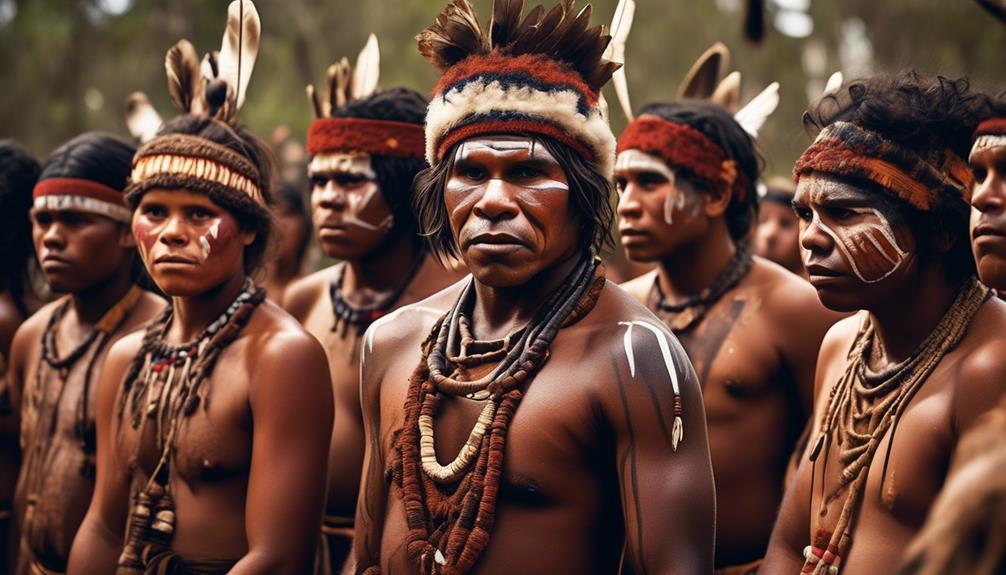
Cultural diversity within the Indigenous communities of Australia enriches our traditions and fosters a deep sense of belonging. Our communities are vibrant tapestries of different languages, beliefs, and practices, each contributing to the rich mosaic of our cultural heritage. Here are some aspects of this diversity that paint a vivid picture of our communities:
- Language Diversity: Our communities are home to a multitude of languages, each carrying its own unique history and worldview. From the lyrical cadence of Yolngu Matha to the rhythmic sounds of Pitjantjatjara, our languages are an integral part of our cultural identity.
- Ceremonial Practices: The diversity of ceremonial practices across our communities reflects the distinct ways in which we connect with our land, ancestors, and spiritual beliefs. From the intricate dot paintings of the Western Desert to the mesmerizing dances of the Torres Strait Islanders, our ceremonial practices are a testament to the depth of our cultural heritage.
- Traditional Knowledge: Our communities encompass a wealth of traditional knowledge, from bush medicine to land management practices. This knowledge is passed down through generations, enriching our understanding of the natural world and sustaining our connection to the land.
- Artistic Expression: Artistic expression takes myriad forms within our communities, from intricate weaving and carving to contemporary visual arts. Each art form is a reflection of our cultural diversity, showcasing the unique creativity and ingenuity of our people.
Embracing and celebrating this cultural diversity is essential for the preservation of our traditions and the continued engagement of our communities in the rich tapestry of Indigenous culture.
Dreamtime Stories
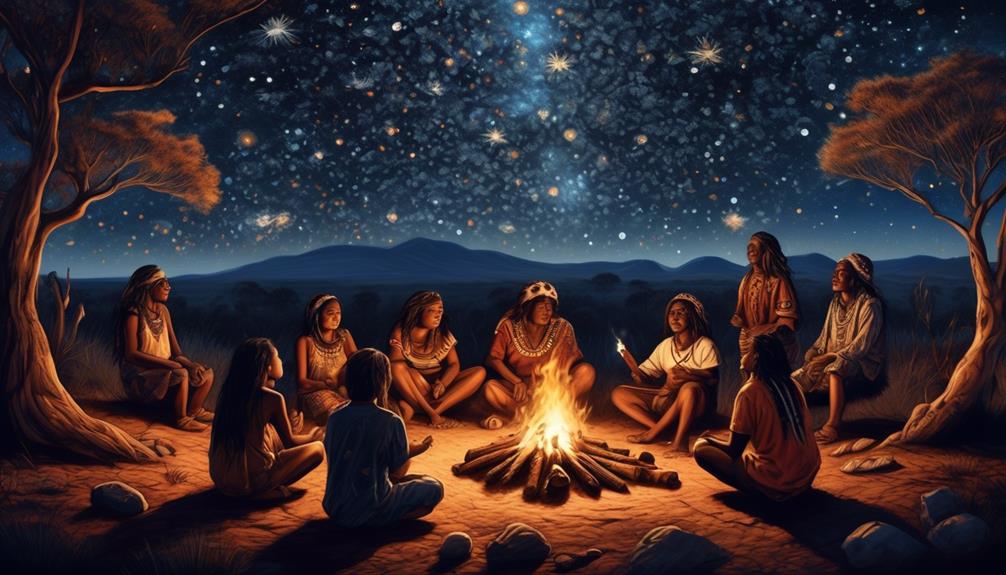
Deeply rooted in our cultural heritage, Dreamtime Stories are a vital part of our identity, shaping our understanding of the world and our place within it. These narratives hold immense Dreamtime significance, serving as a way to pass down knowledge, history, and spiritual beliefs from one generation to the next. Our storytelling traditions are woven into the fabric of our existence, connecting us to the land, the animals, and the celestial beings in a way that's deeply profound and spiritual.
The cultural significance of Dreamtime Stories can't be overstated. They aren't just tales, but rather a way of understanding the creation of the world, the laws that govern it, and our responsibilities as its caretakers. Each story is layered with meaning, teaching us about morality, kinship, and the natural order of things. These narratives also serve as a form of spiritual guidance, providing insight into the unseen forces that govern our lives and the interconnectedness of all living things.
As Indigenous Australians, Dreamtime Stories are an integral part of our cultural identity, and their significance goes beyond mere entertainment or folklore. They're a living, breathing embodiment of our history, our beliefs, and our collective consciousness. By preserving and sharing these stories, we uphold our traditions and pass on invaluable wisdom to future generations, ensuring that our cultural legacy endures.
Contemporary Challenges
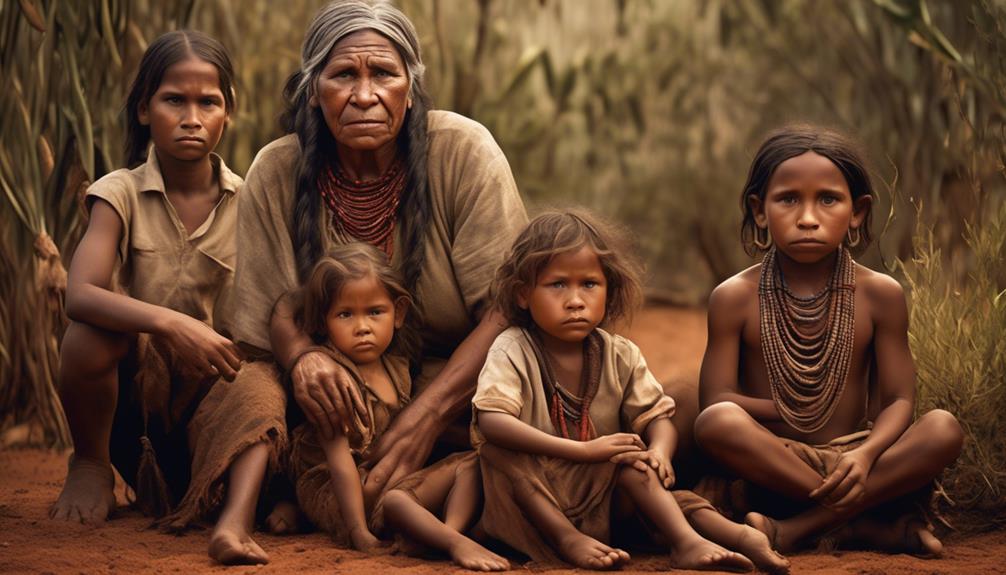
Facing contemporary challenges, we must address the ongoing impact of societal changes on our cultural heritage and traditional way of life. In the face of contemporary struggles, our community resilience remains strong, but we continue to grapple with significant obstacles that threaten our cultural identity and well-being.
- Land Dispossession: The ongoing loss of our traditional lands due to development and resource extraction continues to erode our connection to country and spiritual beliefs. This dispossession undermines our ability to practice cultural traditions and maintain our spiritual connection to the land.
- Health Disparities: The persistent health disparities faced by our communities, including higher rates of chronic diseases and mental health challenges, are a result of historical trauma and ongoing systemic neglect. Access to culturally appropriate healthcare and healing practices is essential for our well-being.
- Cultural Appropriation: The appropriation of our cultural practices, symbols, and knowledge without proper recognition or respect perpetuates the exploitation of our heritage. This exploitation further marginalizes our community and distorts the understanding of our traditions.
- Preservation of Language: The decline of Indigenous languages poses a significant threat to the preservation of our cultural knowledge and connection to our ancestors. Efforts to revitalize and maintain our languages are essential for preserving our identity and passing down traditional knowledge to future generations.
In the face of these challenges, we draw strength from our community resilience and ongoing efforts to address these issues while asserting our rights and striving for a future where our cultural heritage is celebrated and respected.
Health and Wellbeing
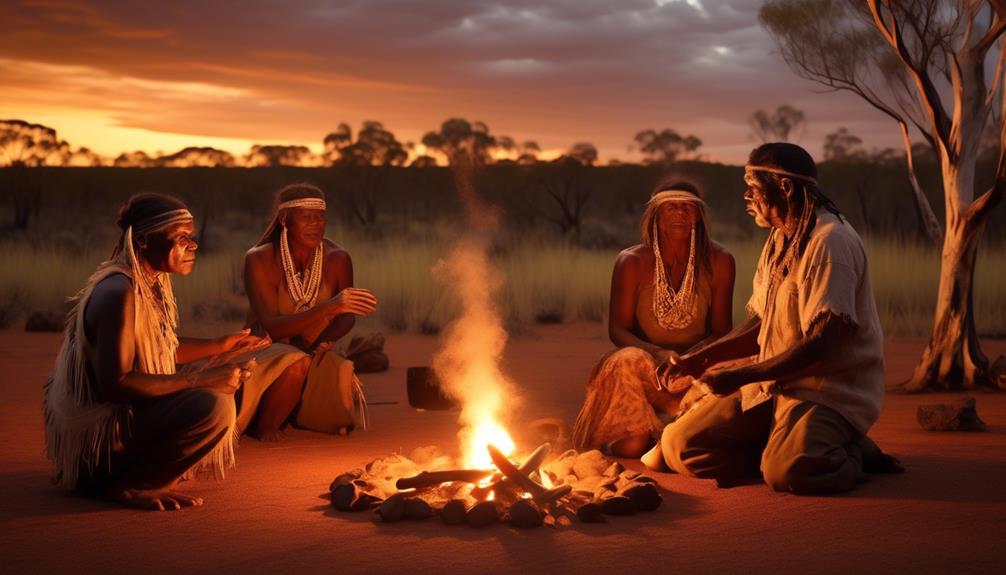
As we confront the contemporary challenges impacting our cultural heritage and traditional way of life, our focus turns to the critical aspects of health and wellbeing within our community. Mental health is a pressing concern, as historical trauma and ongoing societal issues continue to impact our people. It's essential that we prioritize mental health support and create safe spaces for healing.
Our community support networks play a crucial role in providing a sense of belonging and understanding, fostering resilience and empowerment. By coming together, we can address the mental health challenges faced by our people and strengthen our collective well-being.
In addressing health and wellbeing, we recognize the importance of traditional healing practices. Our holistic wellness approach encompasses physical, emotional, and spiritual aspects, acknowledging the interconnectedness of our being. Incorporating traditional healing methods alongside Western medical practices allows for a more comprehensive approach to healthcare. It's vital to preserve and revitalize our traditional healing practices, passing down this invaluable knowledge to future generations.
Our journey towards improved health and wellbeing involves reclaiming our cultural identity and strengthening our connection to the land. This connection is foundational to our overall wellness, providing a sense of grounding and belonging. By embracing our cultural practices and revitalizing traditional knowledge, we can foster a greater sense of purpose and resilience within our community.
Together, we strive for holistic wellness, honoring the wisdom of our ancestors and nurturing the well-being of generations to come.
Education and Employment

We've noticed that Indigenous communities in Australia face significant challenges in accessing quality education, which can limit their opportunities for employment.
Despite these obstacles, there are also initiatives and programs aimed at creating more employment opportunities for Indigenous Australians.
It's important to acknowledge the complexities of these issues and work towards solutions that empower Indigenous individuals to thrive in both education and the workforce.
Education Challenges
Indigenous Australians encounter significant challenges in accessing quality education and securing meaningful employment opportunities. This is due to a range of systemic issues that limit their access to resources and opportunities. Some of the challenges they face include:
- Limited access to quality educational resources and facilities in remote communities
- Cultural biases and insensitivity in mainstream education systems
- Lack of culturally relevant curriculum and support for Indigenous languages
- Limited employment opportunities in their local communities, leading to a cycle of economic disadvantage
These challenges highlight the need for a more inclusive and culturally sensitive approach to education and employment opportunities for Indigenous Australians.
Employment Opportunities
Addressing the challenges faced by Indigenous Australians in accessing quality education naturally leads us to consider the issue of employment opportunities and how it intersects with education. Economic empowerment and community development are essential for Indigenous communities.
Workforce inclusion and entrepreneurship opportunities are crucial for creating sustainable livelihoods. It's vital to foster an environment where Indigenous Australians have access to meaningful employment, fair wages, and opportunities for career advancement. This requires not only addressing systemic barriers but also promoting cultural awareness and respect in the workplace.
Political Representation
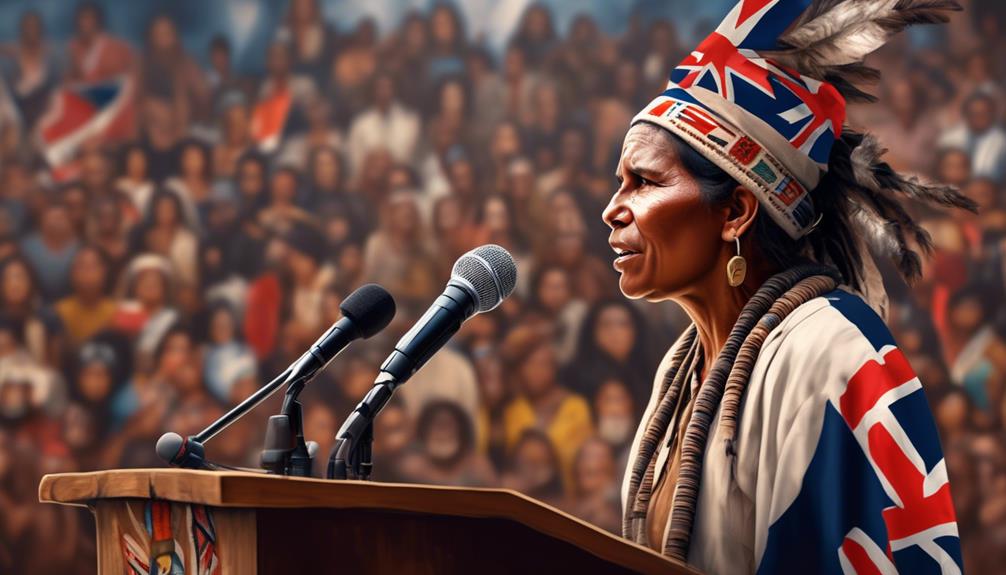
Striving for improved political representation, Indigenous Australians have been advocating for greater inclusion and influence in decision-making processes. As a marginalized community, we're tirelessly working towards achieving political empowerment and ensuring that our voices are heard and respected.
Here are some key aspects of the ongoing endeavor for enhanced Indigenous representation in the political landscape:
- Increased Indigenous Representation: Efforts are being made to secure more Indigenous individuals in decision-making roles within the government and various political bodies. This aims to ensure that our unique perspectives and experiences are directly contributing to policy formation.
- Policy Reforms: We're actively pushing for policy reforms that address the historical injustices faced by Indigenous communities and promote greater equity and social justice. This includes advocating for laws that protect Indigenous rights and cultures.
- Community Consultation: It's essential that Indigenous communities are consulted and engaged in the decision-making process, especially on matters that directly impact our lives. We're working towards establishing mechanisms that guarantee meaningful consultation and participation.
- Partnerships and Alliances: Building alliances with non-Indigenous political leaders and organizations is crucial for advancing our political representation goals. Collaborative efforts are being made to create a more inclusive political environment that respects and integrates Indigenous perspectives.
These efforts are driven by the fundamental belief that true political representation is essential for achieving justice, equality, and liberation for Indigenous Australians.
The journey towards comprehensive political empowerment is ongoing, but we remain resolute in our pursuit of a fair and inclusive political landscape.
Cultural Revival
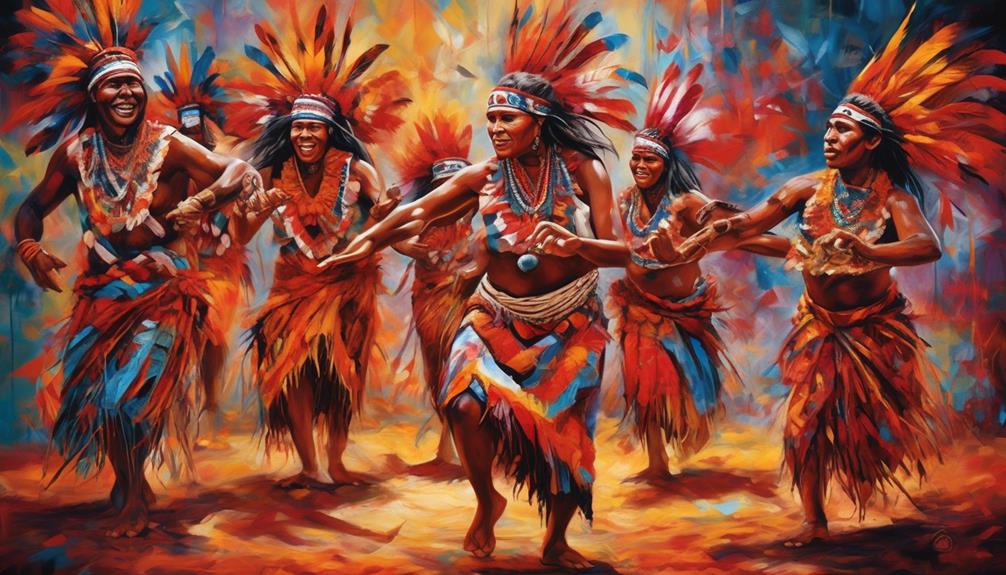
We've seen a beautiful resurgence of traditional indigenous art in Australia, with artists drawing inspiration from ancient techniques and stories to create stunning works that both honor the past and speak to the present.
Additionally, efforts to preserve and revitalize indigenous languages are gaining momentum, recognizing the importance of language as a vessel for culture, knowledge, and identity.
These initiatives are crucial steps in honoring and celebrating the rich cultural heritage of Australia's Indigenous peoples.
Traditional Art Revival
The revival of traditional art among Indigenous people in Australia is a testament to the enduring strength and resilience of their cultural heritage. This cultural renaissance is a powerful expression of identity and a means of preserving artistic heritage.
Indigenous creative expression through traditional art forms fosters a deep connection to the land, ancestors, and spirituality, serving as a source of healing and empowerment for the community.
The revival of traditional art not only honors the wisdom of elders but also provides a platform for intergenerational knowledge sharing. It serves as a vehicle for storytelling, passing down ancient narratives, and celebrating the richness of Indigenous cultures.
Through artistic heritage preservation, Indigenous communities assert their presence and resilience, reclaiming their narratives and asserting their place in the modern world.
Language Preservation
Embracing our ancestral tongues is an integral part of our cultural revival. It fosters a profound connection to our heritage and strengthens our sense of identity.
Language revitalization goes beyond preserving words; it involves reclaiming traditional knowledge and ensuring its intergenerational transmission.
Through community engagement, we actively work to revive and preserve our languages. We recognize them as carriers of our history, values, and worldview.
By speaking and teaching our languages, we reclaim our narratives and empower our communities.
This revitalization effort is essential for our cultural survival and for future generations to connect with their roots.
It is a powerful act of decolonization, asserting our right to language and paving the way for a liberated future grounded in our rich linguistic diversity.
Land Rights
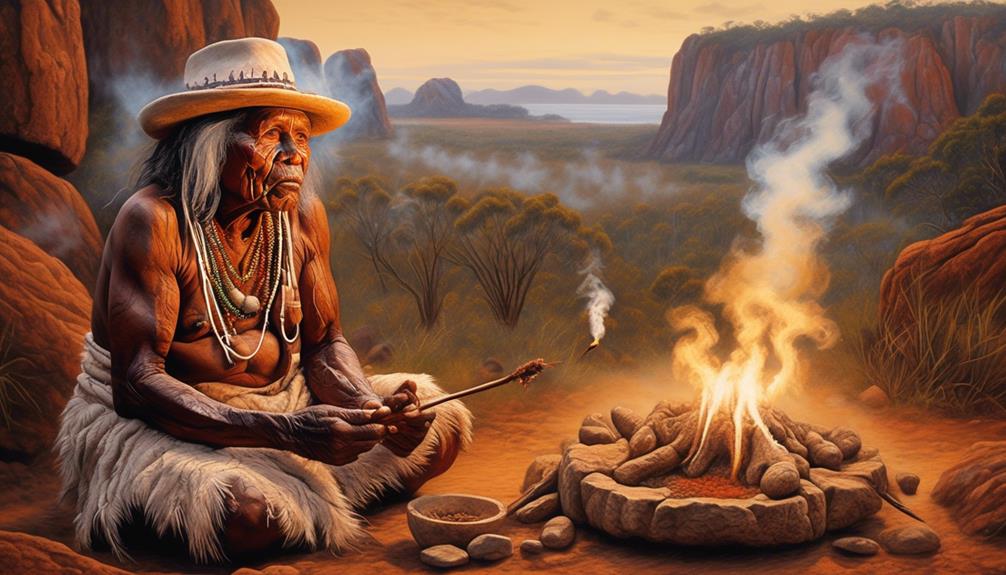
Recognizing the profound significance of land to the Indigenous people of Australia, we acknowledge the pressing need to address historical injustices and ensure equitable land rights for these communities. Land rights activism and the Aboriginal sovereignty movement are pivotal in advocating for the rights of Indigenous Australians.
Here are some key aspects to consider:
- Native Title Act: This legislation acknowledges the rights of Indigenous Australians to their traditional lands and waters, providing a legal mechanism for land rights claims and recognition of traditional ownership.
- Cultural Connection: Land isn't merely an economic or legal asset for Indigenous communities; it's deeply intertwined with culture, spirituality, and identity. Preserving these connections is fundamental to the struggle for land rights.
- Environmental Stewardship: Indigenous people have been the custodians of the Australian landscape for millennia, possessing invaluable knowledge about sustainable land management. Recognizing their rights also means acknowledging their role as environmental stewards.
- Self-Determination: The fight for land rights is intricately linked to the broader quest for self-determination. It's about empowering Indigenous communities to make decisions about their lands, resources, and futures.
The ongoing struggle for land rights exemplifies the resilience and determination of Indigenous Australians in reclaiming what's rightfully theirs. It's a journey marked by both triumphs and setbacks, but it's underpinned by an unwavering commitment to justice and liberation.
Reconciliation Efforts
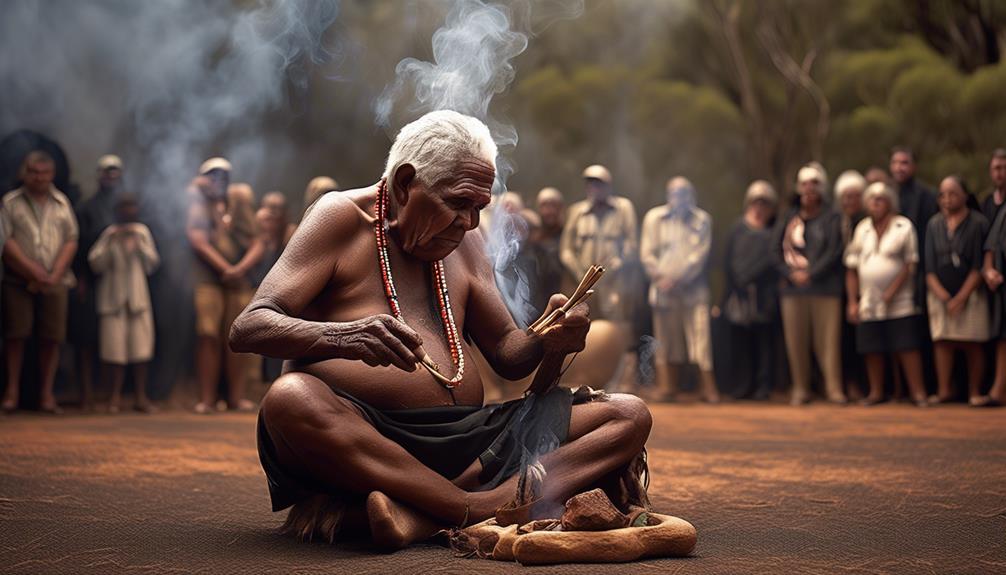
We've made progress in reconciliation efforts through government initiatives, with increased recognition of Indigenous leadership roles and the ongoing work towards land rights.
Our collective efforts have led to positive steps in acknowledging and addressing the historical injustices faced by Indigenous peoples in Australia.
It's important to continue supporting and amplifying the voices of Indigenous communities as we work towards a more inclusive and equitable society.
Government Initiatives
In our efforts to bridge the gap and foster understanding, the Australian government has implemented various initiatives aimed at reconciliation with the Indigenous people. These initiatives prioritize community development and seek to address historical injustices.
Some of the key government initiatives include:
- Closing the Gap: A national strategy aimed at achieving equality in health and life outcomes for Indigenous Australians.
- Indigenous Land and Sea Corporation: Supporting Indigenous landowners in economic and community development by providing funds and assistance.
- Reconciliation Action Plan (RAP): Encouraging organizations to build strong relationships and enhanced respect between Indigenous and non-Indigenous Australians.
- National Indigenous Australians Agency (NIAA): Focused on improving the lives of Indigenous Australians through targeted policies and programs.
Through these initiatives, the government is actively working towards creating a more equitable and inclusive society for all Australians.
Indigenous Leadership Roles
Building on the government's commitment to reconciliation through various initiatives, the focus now shifts to the pivotal role of Indigenous leadership in fostering greater understanding and unity.
Indigenous leadership plays a crucial role in shaping community engagement and representing the voices of Indigenous peoples in governance structures. It's through their guidance and wisdom that the path towards reconciliation is illuminated. Indigenous leaders hold the key to preserving cultural heritage and advocating for the rights and needs of their communities.
Their representation in decision-making processes is essential for creating policies that are inclusive and respectful of Indigenous perspectives. By empowering Indigenous leadership, we can work towards a future where unity and understanding flourish, and where the voices of Indigenous peoples aren't just heard, but valued and respected.
Land Rights Progress
Progressing towards reconciliation, the ongoing efforts to address land rights for Indigenous peoples have become a focal point in fostering understanding and unity. As we navigate the complexities of this journey, it's important to provide progress updates and acknowledge the current challenges we face.
- Recent legislative changes have started to recognize traditional land ownership.
- Collaborative initiatives between Indigenous communities and government bodies are gaining traction.
However, there's still a need for greater consultation and inclusion of Indigenous voices in decision-making processes. Land rights litigation and negotiations continue to be a slow and arduous process, often hindered by bureaucratic red tape and historical injustices.
These updates reflect the ongoing struggle for recognition and justice, highlighting the need for continued advocacy and support for Indigenous land rights.
Future Perspectives

Considering the challenges and opportunities ahead, we must embark on a journey to envision a future that honors and uplifts the Indigenous people of Australia. As we look forward, it's crucial to prioritize cultural sustainability, ensuring that the rich traditions, languages, and customs of Indigenous communities continue to thrive for generations to come.
Embracing future perspectives means recognizing the importance of preserving and celebrating the diverse cultural heritage of Indigenous Australians. This requires a concerted effort to empower Indigenous voices in shaping policies that impact their communities and safeguarding their rights to land, language, and cultural practices.
In envisioning a future that's truly inclusive and equitable, it's essential to foster an environment where Indigenous knowledge and wisdom are valued and integrated into all aspects of society. This involves creating opportunities for Indigenous-led education, promoting economic development that respects traditional ways of living, and elevating Indigenous representation in leadership roles across various sectors. By embracing cultural sustainability in our future perspectives, we can work towards dismantling the systemic barriers that have hindered the full realization of Indigenous rights and well-being.
In moving forward, we must also heed the wisdom of Indigenous elders and knowledge keepers, recognizing their invaluable insights into environmental stewardship, holistic health practices, and community resilience. By centering Indigenous perspectives in our vision for the future, we can foster a society that honors the interconnectedness of all living beings and upholds the sacred responsibility to care for the land and each other.
This journey towards a future that respects and uplifts the Indigenous people of Australia requires collective action, solidarity, and a commitment to justice.
Frequently Asked Questions
What Are the Current Economic Opportunities Available to Indigenous People in Australia?
We believe that economic empowerment and job creation are vital for any community.
Entrepreneurship and land rights play a crucial role in shaping the economic opportunities available to people.
It's important to create an environment that fosters entrepreneurship and supports land rights, paving the way for meaningful economic opportunities.
This approach can lead to sustainable growth and prosperity for all members of the community.
How Are Indigenous Languages Being Preserved and Revitalized in Contemporary Australian Society?
Preserving languages is crucial for cultural revitalization.
It involves documenting, teaching, and celebrating indigenous languages to ensure their survival and relevance in contemporary society.
Language is a fundamental aspect of identity and connection to heritage, so efforts to preserve and revitalize indigenous languages are vital for cultural empowerment and resilience.
It's important to recognize and support these initiatives as they contribute to the rich tapestry of human expression and experience.
What Are Some of the Ongoing Efforts Towards Reconciliation Between Indigenous and Non-Indigenous Australians?
We've seen a significant increase in reconciliation efforts through the implementation of cultural awareness initiatives.
For example, community-led workshops have been organized to foster understanding and respect between Indigenous and non-Indigenous Australians.
These initiatives provide a platform for open dialogue, education, and collaboration, promoting mutual respect and understanding.
It's inspiring to witness the positive impact of such initiatives in bridging the gap and fostering harmonious relationships.
How Are Indigenous Communities Addressing Environmental and Sustainability Issues in Modern Times?
We see indigenous communities engaging with environmental stewardship through community-led initiatives and sustainable practices. They're actively involving themselves in preserving the land, promoting biodiversity, and combating climate change.
Their deep connection to the land and traditional knowledge informs their approach, creating holistic solutions that benefit both the environment and their communities.
This engagement is essential for a sustainable future, and we can learn valuable lessons from their efforts.
What Are Some of the Key Initiatives Aimed at Preserving and Promoting Indigenous Art and Cultural Practices in Australia?
We've seen a resurgence in initiatives aimed at preserving and promoting cultural heritage and art preservation. Organizations and communities are working tirelessly to ensure Indigenous art and cultural practices are celebrated and sustained.
From art exhibitions to cultural festivals, there's a growing recognition of the importance of these initiatives in honoring and preserving the rich heritage of Indigenous people.
It's heartening to witness the commitment to safeguarding these invaluable traditions.
Conclusion
As we reflect on the rich and resilient history of the Indigenous people of Australia, we see a tapestry of strength woven through the land like ancient songlines.
Their cultural revival and ongoing fight for land rights paint a picture of hope and determination, like a flame that refuses to be extinguished.
The future holds the promise of continued reconciliation efforts, like an endless river flowing towards healing and understanding.
We stand in awe of their enduring spirit.
Talise is a talented writer and an expert in her field. Her unique perspective and insights enrich our content with depth and authenticity. With a wealth of knowledge and a strong connection to the subjects she writes about, Talise crafts engaging and informative articles that resonate with our readers. Her dedication to bringing Indigenous culture and wisdom to light is truly commendable.
